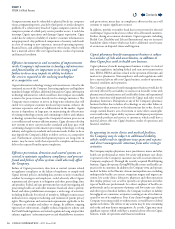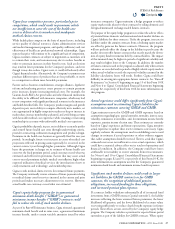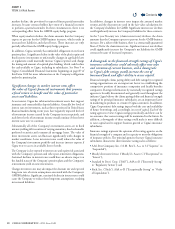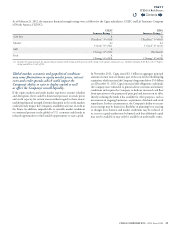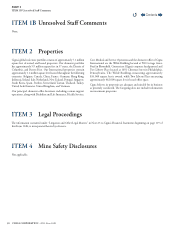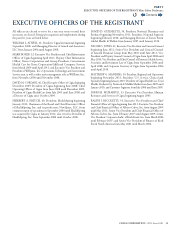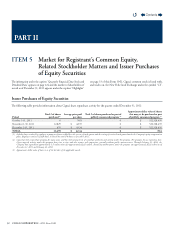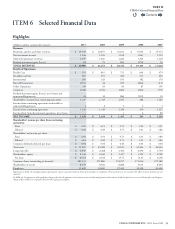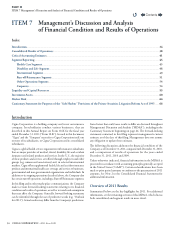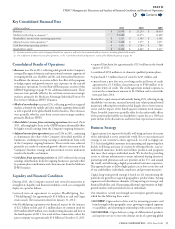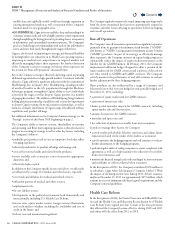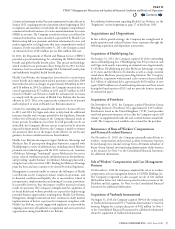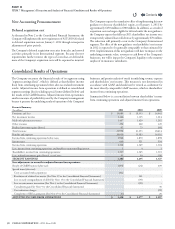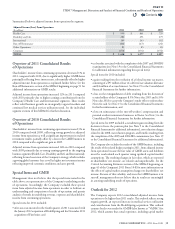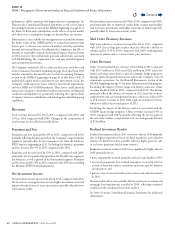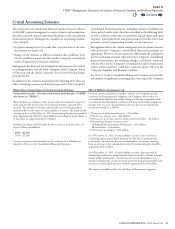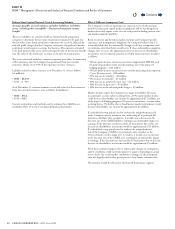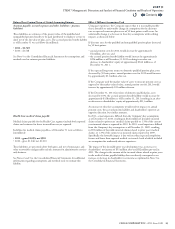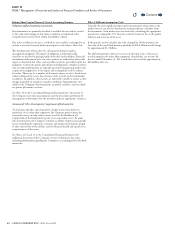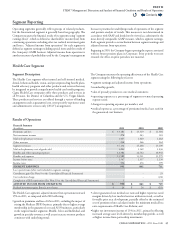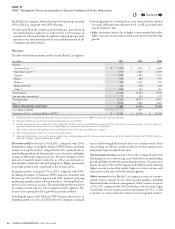Cigna 2011 Annual Report Download - page 58
Download and view the complete annual report
Please find page 58 of the 2011 Cigna annual report below. You can navigate through the pages in the report by either clicking on the pages listed below, or by using the keyword search tool below to find specific information within the annual report.
36 CIGNA CORPORATION2011 Form10K
PART II
ITEM 7 Management’s Discussion and Analysis of Financial Condition and Results of Operations
middle class and a globally mobile workforce through expansion in
existing international markets as well as extension of the Company’s
business model to new geographic areas.
•
GO INDIVIDUAL: Cigna strives to establish a deep understanding of its
customers’ unique needs and to be a highly customer-centric organization
through simplifying the buying process by providing choice, transparency
of information, and a personalized customer experience. e Company’s
goal is to build long-term relationships with each of the individuals it
serves and meet their needs throughout the stages of their lives.
Cigna is also focused on improving its strategic and nancial exibility
by driving further cost reductions in its Health Care operating expenses,
improving its medical cost competiveness in targeted markets and
eectively managing balance sheet exposures. For further discussion
of the Company’s actions to manage its balance sheet exposures, see
the section on “Run-o Operations” discussed below.
Key to the Company’s strategy is eectively deploying capital in pursuing
additional opportunities in high-growth markets. Consistent with this
objective, Cigna achieved a signicant milestone with the acquisition of
HealthSpring,Inc. in January2012. HealthSpring, a leading provider
of medical benets to the 65+ population through the Medicare
Advantage program, strengthens Cigna’s ability to serve individuals
across their life stages as well as deepens Cigna’s presence in a number
of geographic markets. e addition of HealthSpring brings industry
leading physician partnership capabilities and creates the opportunity
to deepen Cigna’s existing client and customer relationships, as well as
facilitates a broader deployment of Cigna’s range of health and wellness
capabilities and product oerings.
For additional information on the Company’s business strategy, see the
“Strategy” section of this Form10-K beginning on page2.
e Company’s ability to increase revenue, shareholders’ net income
and operating cash ows from ongoing operations is directly related to
progress in executing its strategy as well as other key factors, including
the Company’s ability to:
•
protably price products and services at competitive levels that reect
emerging experience;
•eectively underwrite its product oerings and manage risk;
•cross sell its various health and related benet products;
•
invest available cash at attractive rates of return for appropriate
durations; and
•eectively deploy capital.
In addition to the Company-specic factors cited above, overall results
are inuenced by a range of economic and other factors, especially:
•cost trends and ination for medical and related services;
•utilization patterns of medical and other services;
•employment levels;
•the tort liability system;
•
developments in the political environment both domestically and
internationally, including U.S. Health Care Reform;
•
interest rates, equity market returns, foreign currency uctuations
and credit market volatility, including the availability and cost of
credit in the future; and
•federal, state and international regulation.
e Company regularly monitors the trends impacting operating results
from the above mentioned key factors to appropriately respond to
economic and other factors aecting its operations, both in its ongoing
and run-o operations.
Run-off Operations
e Company’s run-o reinsurance operations have signicant exposures,
primarily from its guaranteed minimum death benets (“GMDB”,
also known as “VADBe”) and guaranteed minimum income benets
(“GMIB”) products. As part of its strategy to eectively manage
these exposures, the Company operates an equity hedge program to
substantially reduce the impact of equity market movements on the
liability for the GMDB business. In February2011, the Company
implemented additional hedges designed to oset a portion of the
equity market risk for GMIB contracts and a portion of the interest
rate risks related to GMDB and GMIB contracts. e Company
actively monitors the performance of and will continue to evaluate
further adjustments for these hedging programs.
ese products are also inuenced by a range of economic and
behavioral factors that were not hedged or only partially hedged as of
December31,2011, including:
•a portion of equity market risk for GMIB contracts;
•a portion of interest rate risks;
•
future partial surrender impacts for GMDB contracts, including
equity market risk and election rates;
•annuity election rates for GMIB contracts;
•mortality and lapse rates; and
•the collection of amounts recoverable from retrocessionaires.
In order to manage these factors, the Company
•actively studies policyholder behavior experience and adjusts future
expectations based on the results of the studies, as warranted;
•
actively monitors the hedging programs and will continue to evaluate
further adjustments to the hedging programs;
•
performs regular audits of ceding companies to ensure compliance with
agreements as well as to help maximize the collection of receivables
from retrocessionaires; and
•
monitors the nancial strength and credit standing of its retrocessionaires
and establishes or collects collateral when warranted.
In the rst quarter of 2011, the Company contributed $150million to
its subsidiary, Cigna Arbor Life Insurance Company (“Arbor”). With
the impact of declining interest rates during 2011, Arbor’s statutory
surplus at December31,2011 was approximately $275million, which
remains in excess of minimum risk-based capital requirements and the
Company’s internal guidelines.
Health Care Reform
In the rst quarter of 2010, the Patient Protection and Aordable Care
Act and the Health Care and Education Reconciliation Act (“Health
Care Reform”) were signed into law. Certain of the law’s provisions
that aected the Company became eective during 2010 and 2011
and others will take eect from 2012 to 2018.
Contents
Q


